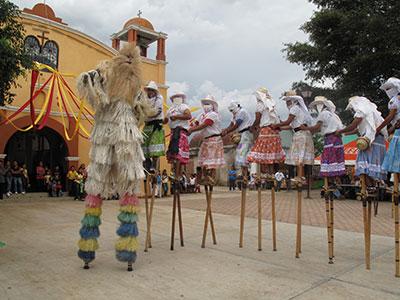With the opportunity to address the idea of serving and protecting within communities to a broadened audience, University of Wisconsin Arts Institute interdisciplinary artist in residence Laura Barbata performed her project “Interventon: Indigo” at the 2015 Macy’s Thanksgiving Day Parade.
Barbata, who worked on the project with the Brooklyn Jumbies and UW professor Chris Walker, said she first got the idea for the project after wanting to address the issues around policing in the U.S.
After being introduced to indigo textiles in Burkina Faso, the power within the fabrics captivated Barbata.
With the hope of creating a street performance with a message, she said she wanted to use the project as a reminder to the public of the meaning of their roles in society.
“We’re not only pointing fingers at police, we’re also saying this is inspiration. We all need to see role of serving and protecting on a higher level, and we also need to have a call to action for all of us to be protecting our communities and inspiring those around us,” Barbata said.
Barbata used indigo colored fabrics to illustrate the power and nobility of the Moko Jumbie, a figure who is meant to serve and protect as well as cleanse and ward off communities of evil in West African societies. She said indigo signifies “absolute truth” and that she doesn’t believe it’s a coincidence the color is popular among law enforcement around the world. Recognizing the collective histories among various cultures, Barbata wanted to bring them together.
The Brooklyn Jumbies, who also participated with Barbata in her May project STRUT! were contacted by Macy’s representatives about the opportunity to be a part of the parade. Barbata said they proposed “Intervention: Indigo” to Macy’s, who then approved the proposal.
“It’s been so exciting and beautiful to share that because I was invited to do this and we bring along all these other great people,” Barbata said. “So it just gives a lot more people that are very talented and have so much to give and share a shared platform and audience.”
In being a part of one of the most internationally known holiday events, Barbata said the process was “long and tiring at first.”
While waking up early for the parade made for the initial fatigue, after seeing the “massive groups” and marching bands surrounding her and her group of 18 dancers, Barbata said the excitement took over.
She said while observing the other performers and their uniformity, the designs of her group stood out because each member was wearing a different costume. But as the group took their places before the performance, other parade member’s compliments and kind wishes reassured Barbata that their group “looked good,” which she said was possible because of their uniqueness.
“It went by so fast and the experience was wonderful,” Barbata said. “It was wonderful to see the expressions of people. People would wave and shout and tell you things. It was really beautiful.”


